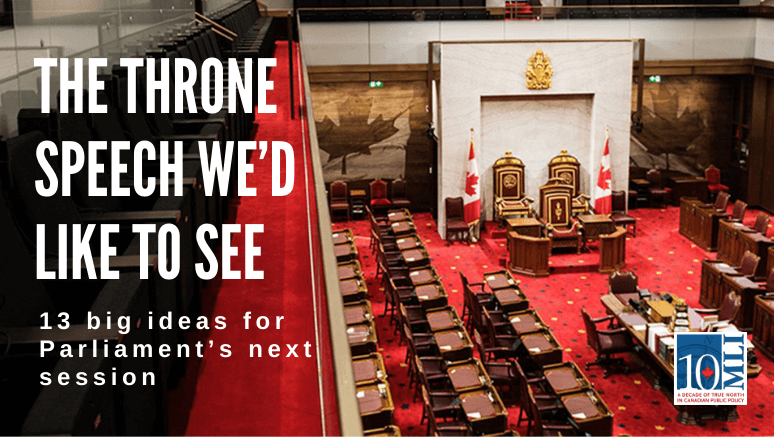 With a historic Throne Speech coming on Sept. 23, the government has many challenges to face with the current pandemic and economic crisis, and a big agenda for the coming session of Parliament. Policy-makers are going to need the best ideas from the best policy minds to help ensure the government achieves its goals of preserving the safety and prosperity of Canadians in the coming months and years. We have asked MLI’s fellows, board members and contributors for their thoughts on the “Throne Speech we’d like to see,” and we received a tremendous response. We would encourage the government to consider these ideas for making Canada even better in the future.
With a historic Throne Speech coming on Sept. 23, the government has many challenges to face with the current pandemic and economic crisis, and a big agenda for the coming session of Parliament. Policy-makers are going to need the best ideas from the best policy minds to help ensure the government achieves its goals of preserving the safety and prosperity of Canadians in the coming months and years. We have asked MLI’s fellows, board members and contributors for their thoughts on the “Throne Speech we’d like to see,” and we received a tremendous response. We would encourage the government to consider these ideas for making Canada even better in the future.
Domestic Policy: Innovation, manufacturing, deregulation and debt reduction should be among key priorities
Philip Cross (Munk Senior Fellow at MLI, former chief economic analyst at Statistics Canada):
Reverse ‘temporary’ fiscal measures post-crisis
Faced with a fiscal crisis in the mid-1990s, the federal government “doubled-up” contributions to Employment Insurance and the Canada Pension Plan. In other words, instead of spreading out contributions evenly over 52 weeks, the government required all contributions for the year to be made in the first six months. At a time of high interest rates, shifting payments forward by up to six months meant considerable savings for a cash-strapped government. The burden, however, was felt by low-income households that do not have the flexibility to easily adjust their cash flow or their savings to meet the new seasonal pattern of taxes.
The 2020 budget represents a perfect time for government to reverse course and spread contributions over the full year. The timing is perfect because interest rates close to zero percent for the federal government means it would cost little money. Yet it would yield a considerable benefit to low income households, which have been disproportionately affected by the pandemic’s impact on low-paying jobs in the personal services sector. These households would now have more flexibility to pay unexpected bills in the first half of 2021. This will be especially important in the spring, when many low-income households will have to pay taxes on their 2020 CERB income, when were mistakenly believed to be exempt from income tax. the PBO estimates that for people in the lowest income bracket, this could mean an unexpected tax bill of up to $2183 that many will struggle to pay.
The more lasting lesson is that governments need to regularly review and overhaul taxes and regulations as circumstances change. As it now stands, actions taken in response to short-term exigencies often remain on the books long after they have served their original purpose. A review of the relevancy of past initiatives should be a regular part of the budget process.
Brian Ferguson (Professor of Economics, Department of Economics and Finance, University of Guelph, member of MLI’s Research Advisory Board):
Reduce spending and target support for business
The government’s response to the COVID economic slump has focused on putting money in people’s hands. This was successful to such an extent that, while GDP fell during the slump, Household Disposable Income rose. At the same time household consumption fell and the household saving rate soared. This is not a situation which can be maintained for any length of time, since it involves heavy government borrowing, both from the markets and from the Bank of Canada, producing massive deficits and driving the national debt up.
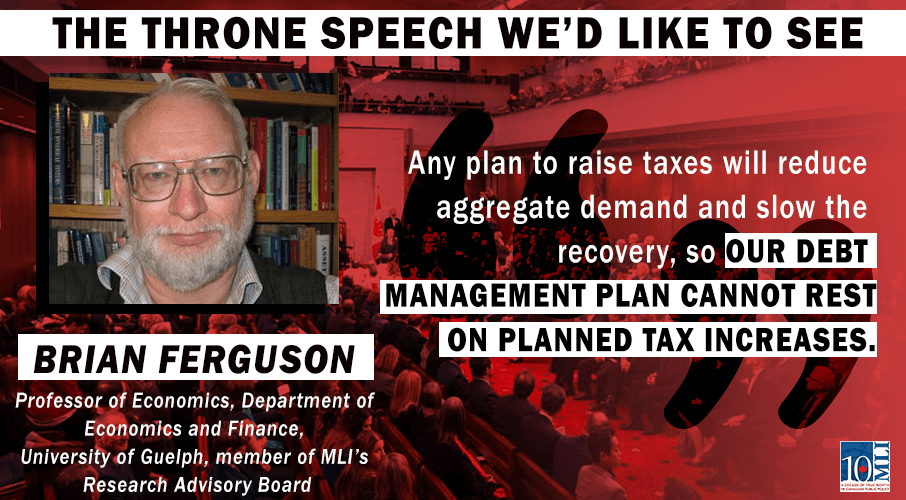 This increase in the debt can be managed so long as interest rates remain low, but it must be realized that the government cannot run deficits indefinitely since, even at low interest rates, an increasing debt will restrict the government’s ability to support necessary spending programs in the future. In addition, whether the interest rates which the government is paying on new debt will remain low will depend on the degree of confidence which financial markets have in the long-term debt management plan.
This increase in the debt can be managed so long as interest rates remain low, but it must be realized that the government cannot run deficits indefinitely since, even at low interest rates, an increasing debt will restrict the government’s ability to support necessary spending programs in the future. In addition, whether the interest rates which the government is paying on new debt will remain low will depend on the degree of confidence which financial markets have in the long-term debt management plan.
The government of Canada will not default on its debt. However, there are other considerations which would make markets uncertain about our ability to support it into the future. Any plan to raise taxes will reduce aggregate demand and slow the recovery, so our debt management plan cannot rest on planned tax increases. One method which governments have in the past used to ease the burden of debt on government finances has involved running higher than normal rates of inflation. This would not be successful in the long run, since any increase in expected inflation will be built into market interest rates. The government has no intention of trying to inflate away the rising debt burden. The Department of Finance is currently in the process of negotiating a new Monetary Policy Framework with the Bank of Canada, and the government will not be asking the Central Bank to raise its target rate of inflation.
Tax and spending policy to this point have focused on getting cash into the economy. In future, those efforts will be more targeted. Large parts of the economy are recovering well from the initial slump, but people-facing sectors – tourism, hospitality and the like – are still in a deep slump and will inevitably take longer to recover than will other sectors. Government support will increasingly be aimed at those sectors, on the supply side by providing tax relief for measures designed to make these work places safer, and on the demand side through targeted cuts in the GST designed to encourage people to shift their spending back towards those hard hit parts of the economy, while always, as individuals, observing sensible precautions.
Jocelyn Bamford (President and Founder of the Coalition of Concerned Manufacturers and Businesses of Canada, founder of responsiblerecovery.ca):
Revive the manufacturing sector
Recently a task force for a green recovery released their plans for the economy after COVID-19, asking for billions of your hard-earned taxpayers’ money. These green energy plans are the same ones that drove up electricity costs in Ontario and led to companies fleeing and massive job losses.
The federal government should announce a plan that focuses instead on a responsible recovery, one that doesn’t require billions of taxpayers’ dollars, one that taps on our world class energy to help lead to a cleaner planet, one that focuses on bring back manufacturing and jobs to Canada so that we will never again be in a situation where we do not have protective equipment in the face of a pandemic. Because who knows better about how to get the economy back on track than those who are on the front lines?
We need to bring back manufacturing. This pandemic has taught us that Canada was in a vulnerable position from offshoring production of our protective and medical equipment. We need to ensure that we are never in this position again and we can do that by bringing back the manufacturing sector.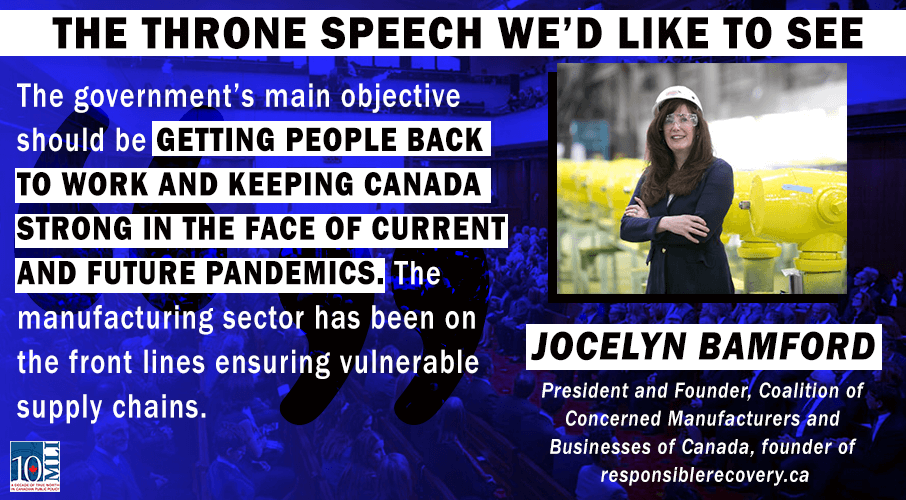
To do this, we must ensure affordable and competitive energy costs. The Green Energy program in Ontario levied the global adjustment charge on electricity bills to pay for wind and solar contracts. This made electricity unaffordable for manufacturing and citizens. We need to ensure that our manufacturing companies can compete and remain in Canada. As well, the average SME achieves net profits of between 1 and 7 percent. New green taxes and regulations like banning plastics could wipe out that margin for many businesses and often do little for the environment.
The government’s main objective should be getting people back to work and keeping Canada strong in the face of the current and future pandemics. The manufacturing sector has been on the front lines ensuring vulnerable supply chains. We have done this safely and we need to ensure that this continues.
Regarding project and pipeline approval, Canada’s clean liquified natural gas can be a vehicle to prosperity for Canada and a cleaner planet, as it may aid in other countries coming off their dependence on coal. We need to ensure that infrastructure jobs have Canadian content so that we can get our people back to work.
Peter Menzies (former vice-chair of CRTC, Senior Fellow at MLI):
Connect the North
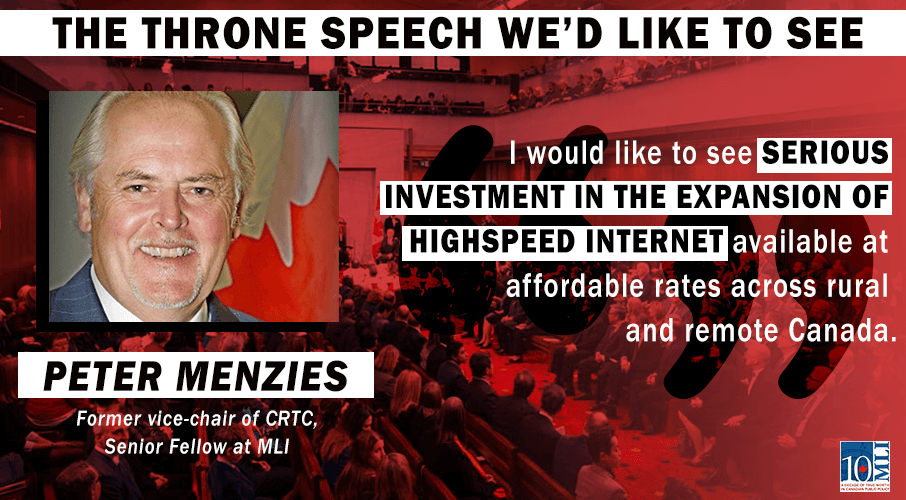 I would like to see serious investment in the expansion of high-speed Internet available at affordable rates across rural and remote Canada – particularly in the northern regions. By northern, I don’t just mean north of 60. In the West, this generally means north of 55. In Ontario, Quebec and the Atlantic, it generally means north of 50. Urban Canada is at serious risk of economic and cultural disconnection from what Macdonald and Laurier would have known as Rupert’s Land. This project is as important today as the railway was a century and a half ago.
I would like to see serious investment in the expansion of high-speed Internet available at affordable rates across rural and remote Canada – particularly in the northern regions. By northern, I don’t just mean north of 60. In the West, this generally means north of 55. In Ontario, Quebec and the Atlantic, it generally means north of 50. Urban Canada is at serious risk of economic and cultural disconnection from what Macdonald and Laurier would have known as Rupert’s Land. This project is as important today as the railway was a century and a half ago.
Jack Mintz (President’s Fellow at School of Public Policy at the University of Calgary, chair of the Alberta Premier’s Economic Recovery Council, Distinguished Fellow at MLI):
Reduce regulation and support investment
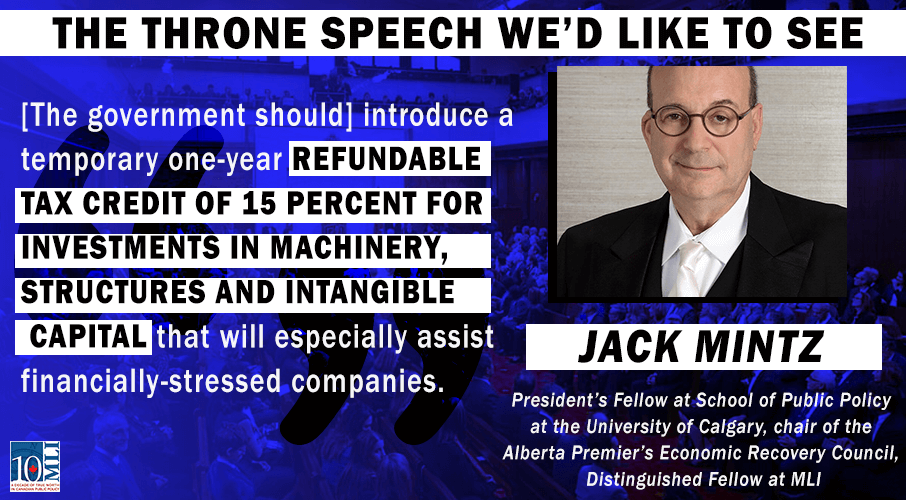 The Government of Canada knows that a strong recovery depends on private investment that has been sorely lacking lately. We will introduce policy initiatives to spur investment. This includes a deregulation effort after consultations with key sectors of the economy. While some regulations are supportive of the public purpose, we know that many have operated at great cost to the economy especially those that no longer serve a purpose. We will also introduce a temporary one-year refundable tax credit of 15 percent for investments in machinery, structures and intangible capital that will especially assist financially-stressed companies.
The Government of Canada knows that a strong recovery depends on private investment that has been sorely lacking lately. We will introduce policy initiatives to spur investment. This includes a deregulation effort after consultations with key sectors of the economy. While some regulations are supportive of the public purpose, we know that many have operated at great cost to the economy especially those that no longer serve a purpose. We will also introduce a temporary one-year refundable tax credit of 15 percent for investments in machinery, structures and intangible capital that will especially assist financially-stressed companies.
Richard Owens (Munk Senior Fellow at MLI):
Create an innovation policy truly based on belief in innovation
To survive and thrive, Canada must become more innovative. Innovation – meaning, broadly, improvements in technologies and ways of doing things – drives a nation’s growth and productivity. It protects the environment and enhances human health and leisure. Along with artistic creation, it enhances the meaning and value of our lives.
Innovation cannot be planned or directed by government. What government can do is create the environment in which innovation might flourish. The culture of curiosity, learning and risk-taking that will make it happen is up to our people, but we will provide education that will encourage it. We trust innovation and ingenuity to address issues of all kinds through private markets. Our citizens are more than up to the challenge.
For a very long time governments knew that innovation is essential to wealth and productivity and to national competitiveness. They assumed that because they wanted innovation’s benefits they could make it happen. Nothing could be further from the truth. We know that now, beyond any doubt. The government charade of backing innovators is no more than using public money for corrupt purposes. It inhibits innovation and lays waste to the possibility of forming a culture of innovation. It funnels hard-earned taxpayer dollars into the hands of political cronies and rich corporations through programs that are almost designed to delay and frustrate the true innovator. We will do this no more. All current government innovation programs are under review and, except for limited competencies essential to the proper functioning of a modern government, will be cancelled. We will not fund private entities to innovate any more, ever.
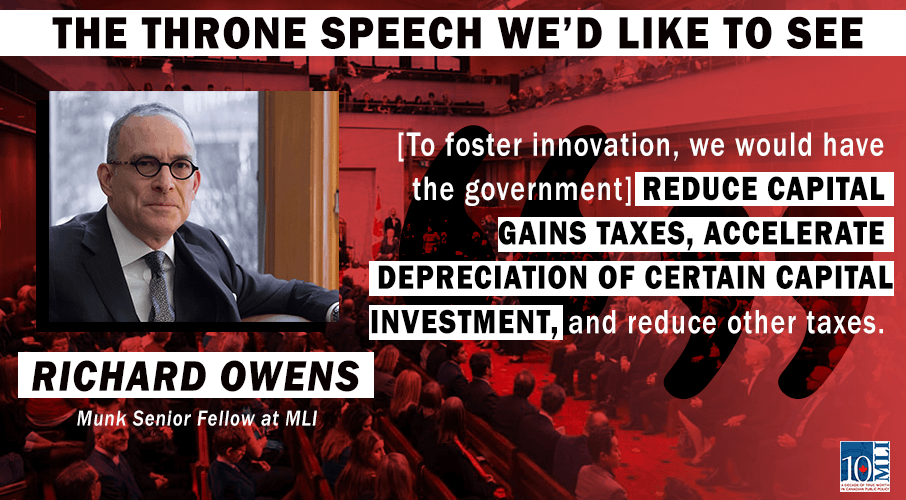 Innovation needs a strong fiscal policy that encourages the accumulation and investment of private capital. As announced elsewhere in this speech, we will further reduce capital gains taxes, accelerate depreciation of certain capital investment, and reduce other taxes.
Innovation needs a strong fiscal policy that encourages the accumulation and investment of private capital. As announced elsewhere in this speech, we will further reduce capital gains taxes, accelerate depreciation of certain capital investment, and reduce other taxes.
Innovation needs freedom, both intellectual and economic. We will ensure that Canada’s robust institutions and rights continue to set the standard for freedom of thought in the world, and through our previously announced red-tape reduction plan we will greatly enhance the efficiency of our economy and the freedom to take new, productive risks in all sectors of the economy. This will be true especially of technology-intensive sectors, including pharmaceuticals. Canada will no longer drive down the prices of pharmaceutical innovations which it does now at great risk to the health of its citizens. The Patented Medicine Prices Review Board will be abolished.
Innovation needs openness. We will continue to lower barriers to international trade and cooperation and draw on the enormous strength of Canada’s multicultural heritage. But we will be fierce about protecting our inventors and their property from foreign predation, and our research networks from foreign infiltration. To this end we will introduce new laws to enhance transparency of foreign investment in any research that benefits from public funding.
Innovation needs strong educational institutions. We will develop and implement controls on university funding that will enhance the intellectual diversity and rigour of our institutions. We will limit tenure of professors to improve the vitality and diversity of our academy. And we will institute new funding programmes designed to better address technological innovation, while increasing also funding for basic scientific research.
Innovation needs strong intellectual property laws. Protecting creators is about more than productivity and justice; It is about nourishing our roots as a society that grows and flourishes through creative endeavours and innovation, not government programmes. We understand how critical IP and technology and art and information are in the modern age. We will introduce legislation to clarify that patentability under the Patent Act is meant to be very broad, and that the mission of the Canadian Intellectual Property Office is to support innovators, not frustrate them. Patent fees for smaller entities will be further reduced. We will also introduce legislation to amend the Copyright Act to clarify and make effective collective rights management. We will reverse the devastation of our publishing sector by removing “education” from fair dealing purposes, and by adding new sections to clarify the true reach of fair dealing in the age of digitization and mass copying. The appalling abuses of fair dealing in the education sector and by online businesses and individuals will be dealt with as strongly as we are able.
Innovation is the key to our future as a nation and as a globe. Canada will proudly assert again its place among the makers and benefactors of the world. We are back.
Shawn Whatley (Past President of the Ontario Medical Association, Munk Senior Fellow at MLI):
Don’t import American issues
We must resist the irresistible pull to become American. We love our neighbours, but we do not need to adopt their policies. Canada shares a heritage with America, which includes a legal tradition, language, and mother country. But the American experiment is unique and has given birth to its own social problems.
Consider a few examples. Canadians value and respect our police officers. The Mountie in dress uniform stands as a symbol of pride for Canadians. We believe in law and order in a way that many Americans find hard to understand.
Or think of Canadian geography and climate. Most Canadians live within a few hundred miles of the same latitude. When it comes to climate, Canadians share far more in common with each other, than the enormous diversity for Americans where some never see snow and others see it most of the year. Our land has attracted and shaped a different kind of people into a lifestyle that can never mimic American life. We should focus on the unique needs of living in the Northern part of the continent. For example, maybe we have a bigger challenge with the working poor than the unique challenge of the homeless in LA? Too often we seem to Canadianize the American problems.
Finally, we might consider our commitment to legitimacy in elections. Canadians do not march and riot when we do not like the outcome of an election. We believe in democracy and respect the legitimacy of a duly elected party to govern. We voice our complaints, but we focus action on the ballot box, not the protest marches.
We need to ask whether we are just trying to recreate American issues in Canada or are we truly focusing on what matters most in Canada. I’d like to see a throne speech that commits to Canada and stops trying to recreate distinctly American issues here.
Foreign Policy: Canada should look to the Indo-Pacific and prepare against disruption
Richard Fadden (former National Security Advisor to the Prime Minister, member of MLI’s Advisory Council):
Investigate Canada’s response to disruptive events
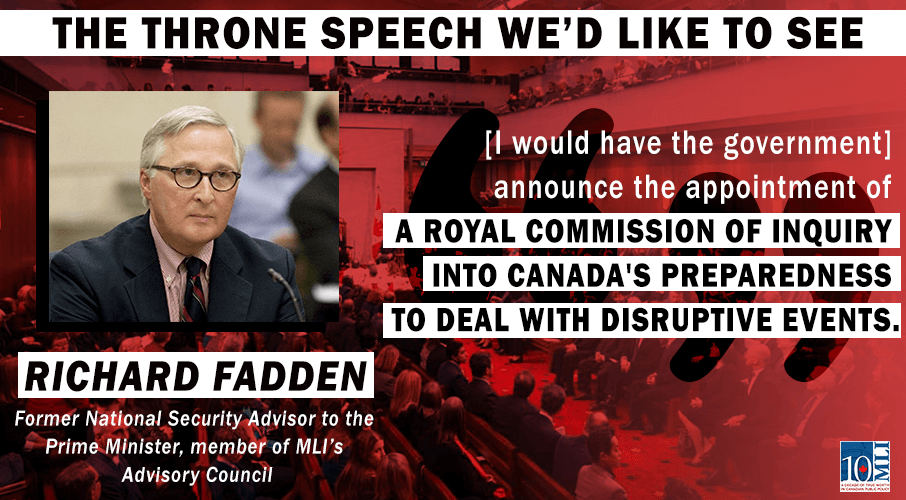 I’ll give you my idea by using the language I’d like to see in the Speech from the Throne: “In the next few weeks, the Government will announce the appointment of a Royal Commission of Inquiry into Canada’s preparedness to deal with disruptive events. Without limiting itself to issues arising from the current pandemic, the Commission will examine the full range of possible disruptive events possibly to occur in Canada in the years ahead and recommend measures to Enhance Canada’s ability to reduce the effects of such events. The Commission shall consider and report on the possible appropriate roles of the province’s and municipalities, the private sector and civil society in dealing with disruptive events. The Government seek the active cooperation of the province’s in the work of the Commission. The Commission shall report with 18 months of its constitution.”
I’ll give you my idea by using the language I’d like to see in the Speech from the Throne: “In the next few weeks, the Government will announce the appointment of a Royal Commission of Inquiry into Canada’s preparedness to deal with disruptive events. Without limiting itself to issues arising from the current pandemic, the Commission will examine the full range of possible disruptive events possibly to occur in Canada in the years ahead and recommend measures to Enhance Canada’s ability to reduce the effects of such events. The Commission shall consider and report on the possible appropriate roles of the province’s and municipalities, the private sector and civil society in dealing with disruptive events. The Government seek the active cooperation of the province’s in the work of the Commission. The Commission shall report with 18 months of its constitution.”
Margaret McCuaig-Johnston (Senior Fellow, Institute for Science, Society and Policy, University of Ottawa and the China Institute, University of Alberta):
Create an Indo-Pacific Strategy
A new Indo-Pacific Strategy would allow Canada to reflect its growing interest and engagement in the region, and to diversify away from the new, more aggressive China that we have been seeing. This Strategy would encompass foreign affairs, trade, and international development. On the trade front, it would be supported by our participation in the Comprehensive and Progressive Agreement for Trans-Pacific Partnership (CPTPP). More broadly, it would reflect our blossoming relations with the Association of Southeast Asian Nations (ASEAN) including through economic, security, education and cultural initiatives. Renewed defence, security and cyber collaboration with like-minded countries in the region, and engagement in such areas as education and innovation with those countries with common interests (a broader set of countries than the like-minded) are other areas of potential focus. As part of the Indo-Pacific Strategy, a new China Framework should identify where Canada will need to continue to work with China in some areas and insulate itself from China’s behaviours in others, considering at the same time China’s relations with other countries in the region.
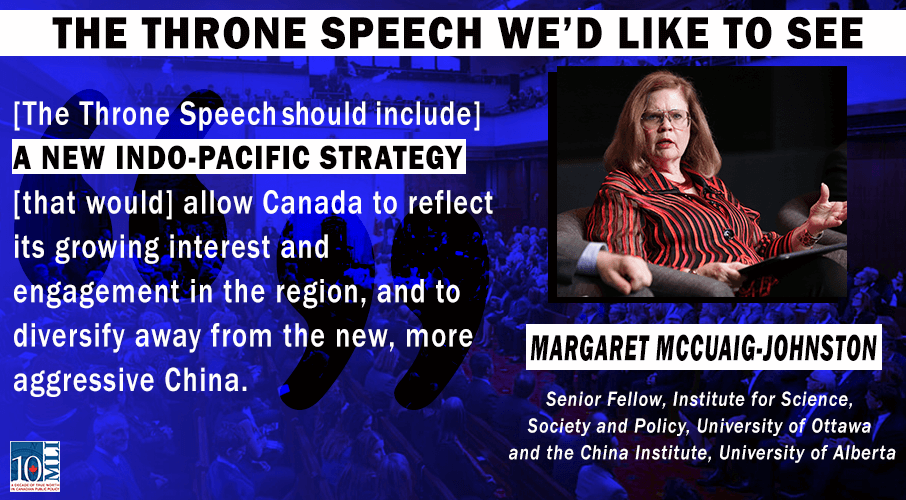 Within the context of this new Indo-Pacific Strategy there should be a renewed focus on support for Taiwan. In the past year, Canada has undertaken consultations regarding Taiwan’s potential membership in the CPTPP. Canadian naval ships have passed through the Strait of Taiwan, recognizing that it was the shortest distance between two places; such presence is at the same time an important signal of support for Taiwan. Canada’s support for Taiwan’s attendance at meetings of international organizations such as ICAO and WHO is another signal that we believe that they should be part of the international information exchange on important matters of air safety and international population health. Other measures should include: enhanced science and innovation exchanges; exploratory discussions towards a Foreign Investment Protection Agreement (FIPA); sending junior ministers to Taiwan for higher-level engagement on matters of common interest; and changing the name of the Canadian Trade Office in Taipei to the Canada Office Taipei, in line with the US, UK, Australian, and Japanese offices. It is imperative that Taiwan, a proudly democratic country, be accorded strong support by all other democracies world-wide including Canada as we have seen daily threats against its security by its larger neighbour.
Within the context of this new Indo-Pacific Strategy there should be a renewed focus on support for Taiwan. In the past year, Canada has undertaken consultations regarding Taiwan’s potential membership in the CPTPP. Canadian naval ships have passed through the Strait of Taiwan, recognizing that it was the shortest distance between two places; such presence is at the same time an important signal of support for Taiwan. Canada’s support for Taiwan’s attendance at meetings of international organizations such as ICAO and WHO is another signal that we believe that they should be part of the international information exchange on important matters of air safety and international population health. Other measures should include: enhanced science and innovation exchanges; exploratory discussions towards a Foreign Investment Protection Agreement (FIPA); sending junior ministers to Taiwan for higher-level engagement on matters of common interest; and changing the name of the Canadian Trade Office in Taipei to the Canada Office Taipei, in line with the US, UK, Australian, and Japanese offices. It is imperative that Taiwan, a proudly democratic country, be accorded strong support by all other democracies world-wide including Canada as we have seen daily threats against its security by its larger neighbour.
Indigenous Affairs: A new approach to Indigenous reconciliation is needed
Sharleen Gale (Chief of the Fort Nelson First Nation, Chair of the First Nations Major Projects Coalition, Senior Fellow at MLI):
Create an Indigenous major projects fund
The Government of Canada often speaks passionately about creating economic opportunity for Indigenous peoples. Indigenous communities responded, launching the most dramatic Indigenous economic re-engagement in Canadian history. But we are stopped from capitalizing on opportunities with major infrastructure projects.
Participating in major project development requires access to large sums of money. For a variety of reasons – the small size of our communities, the constraints of the Indian Act, and multi-generational poverty– Indigenous peoples rarely have the investment capital needed to take ownership positions. The well-known axiom that “It takes money to make money” describes the difficulty facing Indigenous peoples as they attempt to build sustainable economies.
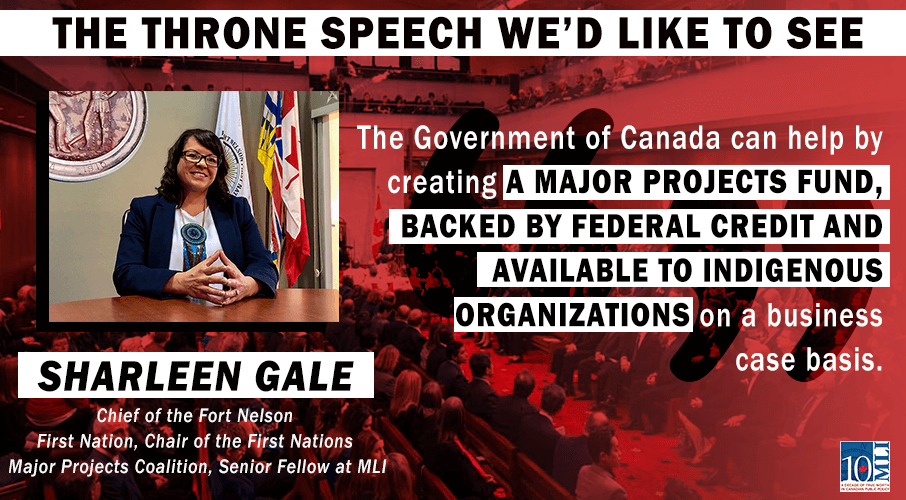 Indigenous communities need money, but as repayable investment capital and not acts of charity. Indigenous communities have generations of experience with welfare payments and paternalism. No thanks! Indigenous communities want to work with commercial partners and industry to build a solid and sustainable economic base. But without access to substantial investment capital on appropriate terms, we will remain on the economic margins.
Indigenous communities need money, but as repayable investment capital and not acts of charity. Indigenous communities have generations of experience with welfare payments and paternalism. No thanks! Indigenous communities want to work with commercial partners and industry to build a solid and sustainable economic base. But without access to substantial investment capital on appropriate terms, we will remain on the economic margins.
The Government of Canada can help by creating a Major Projects Fund, backed by federal credit and available to Indigenous organization on a business case basis. The MPF must work at the speed of business and not at the extremely frustrating pace of government decision-making. The MPF could be established at arms-length from government and Indigenous organizations and could, over time, draw in private sector funding.
Paternalism dies slowly in any government system. Central authorities are well-schooled in the idea that their oversight obligations necessitate federal control over the minor details of business decisions. But as Indigenous communities exercise economic independence, flexible, fastmoving, profit-oriented approaches must take over from federally centred decision-making.
The new system need not be complex. A fund can be set up quickly, informed by but the recently established Alberta Indigenous Opportunities Fund. A line of credit would provide Indigenous communities with access to repayable loans. Decisions would be based strictly on business cases.
Imagine the difference with economically empowered Indigenous communities. They would have the funds to construct residential and commercial initiatives. Rather than building our economic future on passive rents from development, we would leverage current resources into large scale, revenue-producing investments. The funds in turn, would pay for houses, cultural and language programs, further business development.
Until our communities have a comparable level of prosperity as other Canadians – and isn’t that an admirable and achievable goal – the chance to engage as equals is severely constrained. A Major Projects Fund would change the foundations of Canadian and Indigenous investment, with the Government of Canada recovering all of their investments.
If the idea intrigues the Government, Ottawa must not simply announce such a program, even with a large sum of money attach to it. Instead the Government of Canada should start a conversation with Indigenous peoples about the Fund. The terms, structure and mandate of the MPF would co-produce policy that fits within Government rules and constraints and that meets Indigenous needs.
Indigenous communities are well-prepared for a reconciliation-based approach to economic development and for full and sustained engagement in the post-pandemic recovery.
Dan Pujdak (Senior Fellow at MLI):
Key idea: A Northern Critical Infrastructure Investment Plan
Delivery Mechanisms: point-of-sale tax free infrastructure bonds to enable lower borrowing costs (like US municipal bonds), creating a northern directorate for Canada’s Infrastructure Bank, unlocking private investment by committing Canada as an anchor tenant for key port/road/air strip infrastructure, create a special northern economic zone with federal tax incentives for investors
If life goes “back to normal” in Inuit Nunangat and the three Northern Territories, there might not be much to celebrate. Transportation infrastructure deficits, which are key barriers to economic development, access to health care, and lowered costs of living will still remain. Is a North that is uncoupled from the south really in the best interests of anyone?
 These deficits are also a threat to Canada’s national security and sovereignty. This summer, the United States and Russia stepped up military operations in the Arctic. China, which has declared itself a “near arctic” state with an interest in creating a “Polar Silk Road” (what we in Canada call the Northwest Passage), has also made plays. Geopolitical positioning is more than moving warships: it is – and is increasingly becoming – a game about strategic investments, where financial return can matter less than strategic return.
These deficits are also a threat to Canada’s national security and sovereignty. This summer, the United States and Russia stepped up military operations in the Arctic. China, which has declared itself a “near arctic” state with an interest in creating a “Polar Silk Road” (what we in Canada call the Northwest Passage), has also made plays. Geopolitical positioning is more than moving warships: it is – and is increasingly becoming – a game about strategic investments, where financial return can matter less than strategic return.
The domestic and international dimensions created by Canada’s lack of historical investment and lack of a plan forward should ring alarm bells, and should smell like opportunity for the Government to at least close on Canadian deficit. In 2019, Canada released an Arctic and Northern Policy Framework with a big vision for the future of the North. This Throne Speech is the time to say how that vision will be articulated, starting with a plan to invest in critical transportation infrastructure.
The plan doesn’t need to be solely funded by Canada – there are plenty of opportunities to incentivize Bay Street, northern trusts, and others. Canada can create a special economic zone with tax benefits for investors, borrow from the U.S. model and allow tax-free territorial and Indigenous bonds for infrastructure development, and commit to being an anchor tenant for assets that the government will actually have to use (e.g., airstrips for medical evacuees, fueling stations for defence, etc…).
If we don’t invest in our infrastructure, someone else might. Will we be happy then?
Theresa Tait-Day (hereditary chief of the Wet’suwet’en Nation):
Indigenous people should be allowed to make their own decisions
The internal disputes within the Wet’suwet’en communities have attracted national and international attention, in large measure through the efforts of environment non-governmental agencies. The story is well-known. Some male hereditary chiefs oppose the Coastal GasLink pipeline. The elected Chiefs and Council and most Wet’suwet’en, including Hereditary people support this carefully managed resource development project.
A community-level dispute about a major initiative, like a pipeline, is hardly new. This matter has been discussed exhaustively within the Wet’suwet’en communities and the decision to support the pipeline came only after extensive, and at times painful, debate.
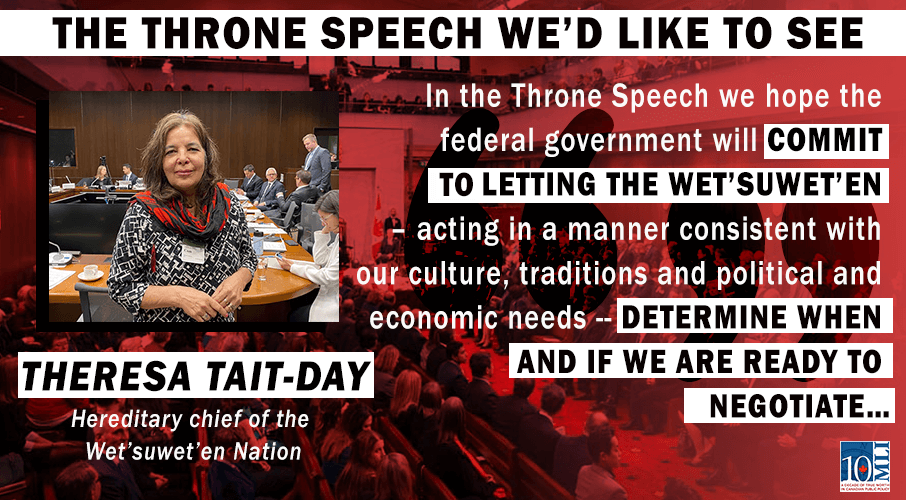 Most unusually, the intervention of the Governments of Canada and British Columbia have made a difficult situation much worse. The two governments, perhaps to avoid an escalation of environmentalist-led conflict, opted to negotiation only with some of the Hereditary Chiefs. The communities were not consulted, and the negotiations were not endorsed or supported by the Wet’suwet’en Nation members. Remarkably, the governments choose to meet only with a self-selected group of Hereditary Chiefs, even though any final agreement must be ratified by the members in an open and transparent in an inclusive manner by Wet’suwet’en members wherever they reside. Members and must be given a vote on resource development. This must be done by the establishment of a Wet’suwet’en Central Government, that represents the fabric of Nation.
Most unusually, the intervention of the Governments of Canada and British Columbia have made a difficult situation much worse. The two governments, perhaps to avoid an escalation of environmentalist-led conflict, opted to negotiation only with some of the Hereditary Chiefs. The communities were not consulted, and the negotiations were not endorsed or supported by the Wet’suwet’en Nation members. Remarkably, the governments choose to meet only with a self-selected group of Hereditary Chiefs, even though any final agreement must be ratified by the members in an open and transparent in an inclusive manner by Wet’suwet’en members wherever they reside. Members and must be given a vote on resource development. This must be done by the establishment of a Wet’suwet’en Central Government, that represents the fabric of Nation.
This central government is critical for the nation moving forward toward resource development. Government must support this vital mechanism that will allow Wet’suwet’en self-governing through sustainable economic resource development that will benefits the Wet’suwet’en, Canada and the British Columbia.
In the Throne Speech we hope the federal government will commit to letting the Wet’suwet’en – acting in a manner consistent with our culture, traditions and political and economic needs — determine when and if we are ready to negotiate such pivotal arrangements.
The resolution of land claims and the re-establishment of Wet’suwet’en central self-government are two of the most important stages in the political development of the Wet’suwet’en. The search for a solution must start and end with the Wet’suwet’en.
Sean Willy (President and CEO of Des Nedhe Development (English River First Nation)):
Let’s see some real acts of reconciliation
For the last decade, Canada has been awash with the rhetoric, but not the reality, of reconciliation. While First Nations, Metis and Inuit people have made real progress – on legal rights, self-government and particularly business development – substantial improvements in living conditions and life opportunities remain elusive for far too many Indigenous people in Canada.
The approach of government, clearly well-intentioned by the Trudeau government, has been to equate the expenditure of money with affection for Indigenous peoples. For decades, we have lived with cheque-book reconciliation, with governments believing that allocating vast sums of money will improve Indigenous quality of life. Money matters, but it is outcomes that are truly significant.
Follow, for example, the current government’s promises on the provision of clean water to Indigenous communities. The commitment is real, money has been provided, many communities have clean water supplies (but often not appropriate delivery systems). But at the same time, the same communities have woeful Internet service, a digital vulnerability shown to be a massive liability during the pandemic. Clearly, Indigenous communities have had enough of grandiose promises.
It is time to change the conversation on Indigenous infrastructure. The provision of key infrastructure – water, electricity, Internet, roads, fire protection – should be seen as a core commitment and not an act of generosity. Equally, Indigenous communities need appropriate investments in mental health infrastructure, including recreational, spiritual, education and health facilities.
A new approach would require two things.
First, the Government of Canada would simply declare that all Canadians, Indigenous and otherwise, deserve and will be given a minimum standard of public infrastructure and facilities. Canada has done this reasonably well for non-Indigenous communities; it has fallen well short for Indigenous peoples. Scandinavian countries have implicitly made this commitment.
Second, and recalling the Government of Canada’s earlier discussion of “deliverology,” the government must review the quality of infrastructure in Canadian communities and, having made a commitment to meeting minimal standards, report annually to the country about progress to articulated goals.
No Canadian can legitimately question the value of reaching for minimum national standards in infrastructure. Indigenous communities have lived for decades with miserable, often dangerously deficient facilities and basic services. It is not enough for the Government to simply talk about moving slowly toward imprecise and undefined goals. Set the bar, allocate resources toward that objective, and move quickly toward achieving what should always have been a national priority.
Indigenous peoples are committed to the ideal and the practical manifestations of reconciliation. The communities have been extraordinarily patient and have tolerated conditions that no other part of Canadian society would have accepted without howls of protest. Let us put Canada on a path to equality of opportunity and sustainable reconciliation by bringing Indigenous communities up to par in terms of core public infrastructure.
To arrange an interview with one of these experts or to find out more about the areas in which MLI can offer public policy expertise, please contact:
Brett Byers
Communications and Digital Media Manager
613-482-8327 x105
brett.byers@macdonaldlaurier.ca




